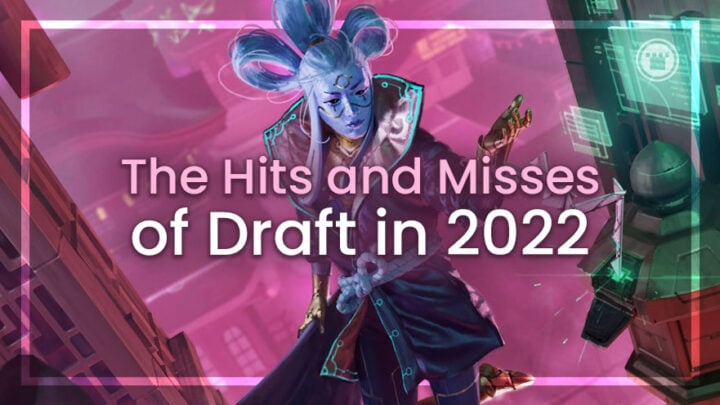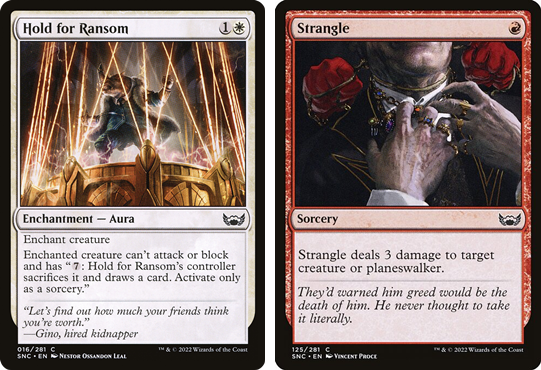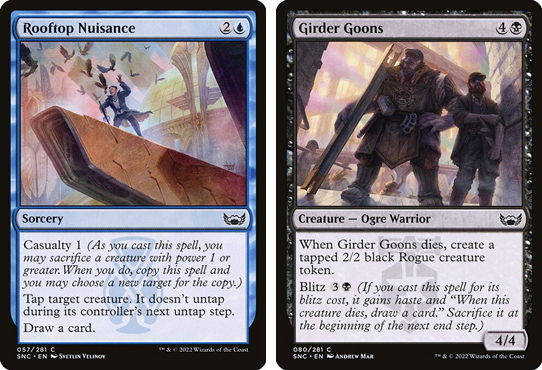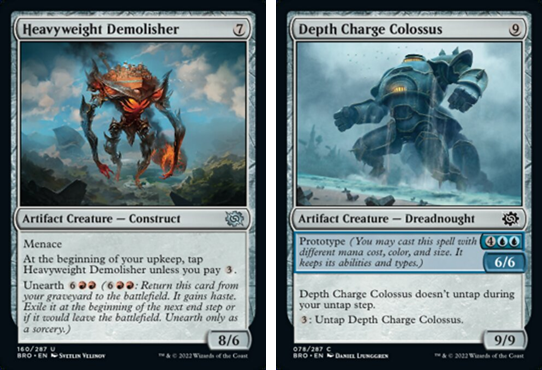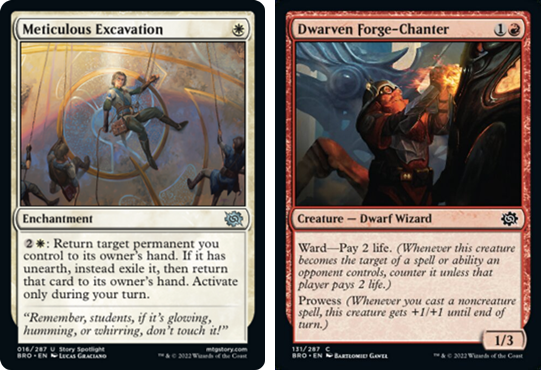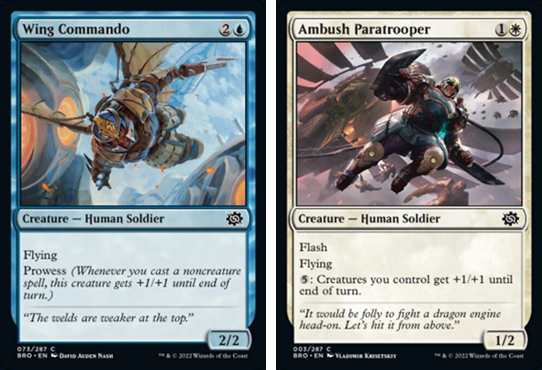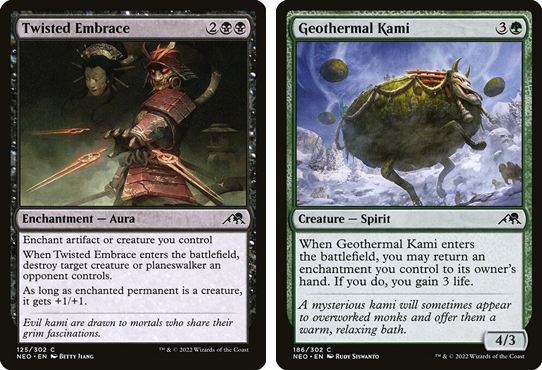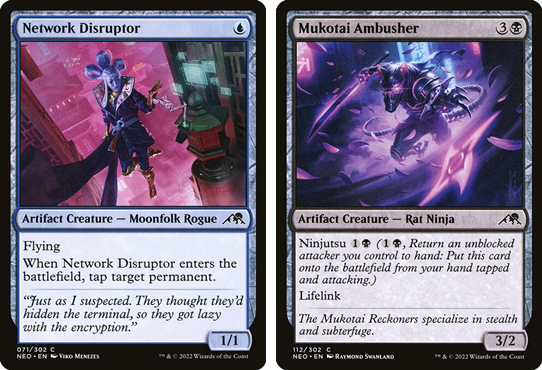Magic has been enjoying something of a golden age for Limited set design: a near-unbroken string of good-to-great formats, arguably stretching back to 2018’s Dominaria. And while players could still feel this run of form through most of 2022, they also saw evidence that an inevitable regression is coming. To sort out which sets belong in each category, I’ve created my ranking of 2022 Draft sets — from my least favorite to the best.
Streets of New Capenna: 3/10
If you wanted to make the case that 2022 killed off Wizards of the Coast’s golden run of Limited design, then Streets Draft is where you’d look for the body. Much maligned by the public and pro players alike, some fundamental pace-of-play issues drowned out anything I might have otherwise enjoyed.
Most great draft formats have ways to incentivize attacking, but Streets leans so far into those mechanics that it falls down on its face. The set boasts some impressive variety among said mechanics, and on paper the individual card designs are some of my favorites of the year. But when almost every card is significantly better when ahead, while attacking or during your own turn, you are going to get some supremely one-sided games of Magic.
My problems start with the dearth of instant-speed removal, especially at common. Murder and Kill Shot are your best options, but with how fast games go, it’s still rare to play another spell that turn while holding up three mana (the sort of turn that lets you actually catch up from a board deficit).
On the other hand, there’s a ton of cheap and powerful combat tricks and sorcery-speed removal options for players to utilize when on the attack. This turns SNC draft games into something like tenpin bowling. One player spends every turn trying to set up a group of plausible blockers just so the other player can dramatically knock them over.
Of course, that’s assuming you’re able to block in the first place! SNC’s creature base is a whirlwind of tap-down effects, “can’t block” effects and combat superiority keywords which make blocking disastrous. Flyers are a particular pain point, with Celestial Regulator and Inspiring Overseer serving as big reasons for the hegemony of UWx decks in Streets draft during its time in the spotlight.
The perfect storm of offense carries through to the set’s signature mechanics. Almost all of them feel unplayable from behind; either because they specifically require attacking/sacrificing potential blockers or they take too much time to pay off.
This even includes SNC’s emphasis on three-color crime families, which turned out to be a trap for the unwary. In practice, almost all decks are better off in two-color with a potential splash, partially because stumbling on mana in the early game is lethal.
The speed with which combat damage adds up, and the superior mana efficiency of offensive tools like Strangle and Grisly Sigil, means there’s rarely any room for the defender to play around these cards or create any difficult choices for the player with the lead — not when you have to tap out every turn to set up new tenpins!
Even when a card’s offensive and defensive worth seem equal, the player in front will be able to cast it on optimal targets with impunity. Meanwhile, a defensive player is forced to telegraph their play by holding up mana and can be easily pressured into acting first and getting their spell blown out.
Streets of New Capenna had a lot of cool ideas, and I hope we can revisit them in a sequel set. But I am never going back to this format — not for all the Halo in the world.
Dominaria United – 5/10
I was initially very high on this set, and I still think that at the nuts-and-bolts level, the format is pretty well balanced. There’s some novel playstyles to shoot for with Domain effects and Walls (well, novel the first five times you see it) and a bunch of cool uncommon legends.
Strong creatures and strong removal are both widely available across the color pie. The Domain cards and off-color Kicker costs were very finely tuned, creating real decisions around how many colors to play or splash in each draft. And the emphasis on Kicker and activated abilities as places to spend mana over straightforward card advantage is one I appreciate.
But as time went on, even though I felt I understood the set better, my enjoyment sharply fell off. Like other draft formats from this year, DMU seemed to shun clearly-delineated archetypes, instead offering all decks a mix-and-match pool of common themes to utilize.
Unfortunately, the themes here were much more hit and miss than in Neon Dynasty. Apart from Domain, there just weren’t enough cards to support most of them unless you hit hard on some key uncommons. I started to feel like I was playing an old Core Set format, with few real synergies to play toward and simple, low-impact spells.
Maybe this was intentional! Wizards said Adventures in the Forgotten Realms was designed as an unofficial Core Set product for last year. But if that was the case, the execution came off poorly.
The low power level of cheap creatures made it hard to consistently beat down against so many walls, tokens and discounted curve-toppers. While there was some potential in combat tricks and pump effects, defenders could utilize those just as well — and then you factor in explicitly defensive removal like Runic Shot and Artillery Blast, or tempo tools like Tolarian Geyser.
Enlist was a disastrously bad mechanic, offering very little benefit to attackers in most scenarios. In many games, even the humble Splatter Goblin felt like an impenetrable barrier.
In the end, many decks just lacked any sort of tools to crack a game open, and the resulting lack of excitement saw me drop off DMU much sooner than expected.
The Brothers’ War – 7/10
While BRO and DMU might both be hit and miss in terms of my personal enjoyment, it’s for very different reasons. I’d rather see Wizards roll the dice with a unique-if-clunky set design like The Brothers War than a routine-and-uninspired one any day.
If you haven’t yet had the chance to dive into BRO (or read through my introduction to the format), it goes all in on recreating the surreal clash of titanic machine armies its title evokes. Every color gets the tools to ramp, recur and scale to late game, as well as the seven, eight and nine-mana threats to cast once they get there!
There’s a solid blend of universal themes (mostly around graveyards and artifacts) with more traditional color-pair archetypes like blue/white soldiers, red/black sacrifice, blue/black draw-two and blue/red Prowess.That said, the high proportion of colorless artifacts in the set makes mono-color decks highly plausible, and there are some exciting payoffs for those too — which is another welcome novelty.
BRO is a draft format that is definitely doing cool things. And compared to some of the others from this year, I haven’t really had the time to explore it deeply. I’ve got maybe a quarter as many BRO drafts under my belt so far as I did for Streets of New Capenna or Neon Dynasty.
Yet, I do have my misgivings, and as I play more drafts, I begin to suspect their causes aren’t so much design bugs as intentional features of this format.
As you might expect, the sheer size of those gigantic robot threats makes them a focal point of many decks. As with Vehicles in Kaladesh block, the presence of such dominant, colorless threats leads to the same cards defining a lot of games, regardless of what decks you build around them.
That’s not to say there’s no difference between a blue/green deck ramping out a Hulking Metamorph and a red/black deck milling one over and reanimating it. But it’s more similar than those color archetypes would feel in nearly any other set.
This sense of inevitability isn’t helped by the fact that so many of the big bodies are basically interchangeable. Would you prefer the 8/6 menace that taps itself unless you pay three each upkeep or the 9/9 that you can only untap by paying three mana?
Another consequence of the commitment to design a “giant robot battle” format is way too many spells feel like pure support cards compared to the pool of available payoffs. This is definitely a recurring problem for sets trying to force an unusual playstyle, such as Strixhaven: School of Mages or War of the Spark.
Combined with the small pool of overrepresented colorless cards and similarity of gameplans, it feels hard sometimes to find direction or identity for your decks. Perhaps there needed to be an extra live-in-graveyard mechanic or two besides unearth (surely something like scavenge would have fit) to increase the variety and quantity of self-mill payoffs.
My final critique is much more straightforward: we have yet another set where blue/white air superiority is out of control. Those two colors get five excellent flyers at common between two and five mana (plus Air Marshal). The combined air force of other colors amounts to Carrion Locust, Fallaji Dragon Engine and Swiftgear Drake (plus two more uncommons).
Even throwing in the handful of cards with reach, it feels far too easy for these cheap and plentiful flyers to beat you down unopposed, especially when you need to also save removal for any giant robots they might follow up with. Perhaps the design intent behind this aerial imbalance is you should just try to advance your own plan and race the flying clock? But with the rest of the set emphasizing late game plays and flooded with low-impact enabler spells, that too often ends up as a pipe dream.
Kamigawa: Neon Dynasty – 9/10
I mentioned I’d save my best review for last, and I am among a significant number of drafters who hold Neon Dynasty in the highest regard. The set just seemed to lock onto great balance points for some of the biggest design questions in Limited: fixing vs. color requirements, lifegain vs. reach, removal vs. bombs, tempo vs. card advantage, synergy vs. card quality and even rares vs. commons.
Every color combination felt like it had an identity despite the relatively loose mechanical themes — a gamble which itself paid off in how easily three-plus color decks and creative splashes came together. I love that so many of the mechanics focused on permanents in play, and in a way which forced players to enact a game plan over multiple turns. Sagas are the obvious example, but Vehicles, Ninjutsu and Modified all required the use of multiple cards over multiple turns to reap your reward.
Having so many mechanics encourages (or requires) attacking. And when combined with a strong overall spread of removal, board stalls and value engines weren’t the sole focus.
My sole reason to not give NEO a 10/10 is that a few themes felt a step behind the rest in power or consistency (blue/white vehicles, red/green modified and blue/red artifacts come to mind). The softer touch with archetypes meant you could still do very well in these colors, but only rarely could you afford to commit to the synergies the way you could with Ninjas or Samurai.
This set is a kami’s whisper short of perfection, but you’d hardly notice after experiencing all the delights this set has to offer.
End step
There you have it — a quick sojourn through 2022’s Standard Draft environments. This year’s trend away from clearly-defined color-pair archetypes is as big a shift in design philosophy, as I can remember. It makes it easier to appreciate the playstyle of each set, not just each color, which is especially helpful for color pairs like red/white, which more or less play the same way every time.
But for all the positives of this approach, this year also showed us its downsides. Streets of New Capenna and Dominaria United were also built around overlapping set-wide mechanics; but those mechanics had negligible or even negative effects on games. Because the themes themselves were omnipresent, so were the problems, and it was hard to escape the negative vibes for even a single draft.
Luckily, Wizards has already shown signs they’re reacting to those missteps — and certainly the Limited design team has earned a little patience at this point!. My guess is in 2023 we’ll see more of a balance between this sort of set design and classic Draft formats built around clear archetypes. And if we get even one format on the level of Neon Dynasty out of it, I’ll be calling it another good year!

Tom’s fate was sealed in 7th grade when his friend lent him a pile of commons to play Magic. He quickly picked up Boros and Orzhov decks in Ravnica block and has remained a staunch white magician ever since. A fan of all Constructed formats, he enjoys studying the history of the tournament meta. He specializes in midrange decks, especially Death & Taxes and Martyr Proc. One day, he swears he will win an MCQ with Evershrike. Ask him how at @AWanderingBard, or watch him stream Magic at twitch.tv/TheWanderingBard.

